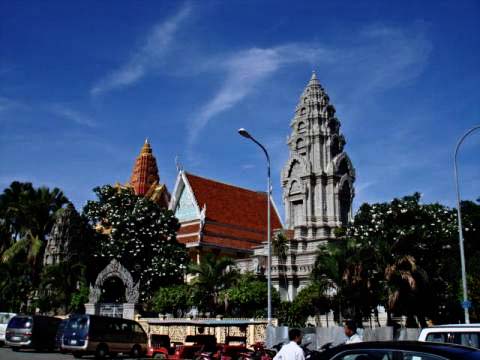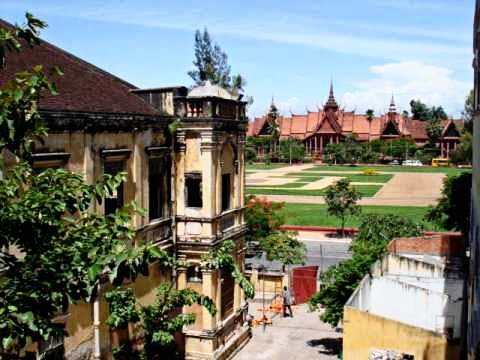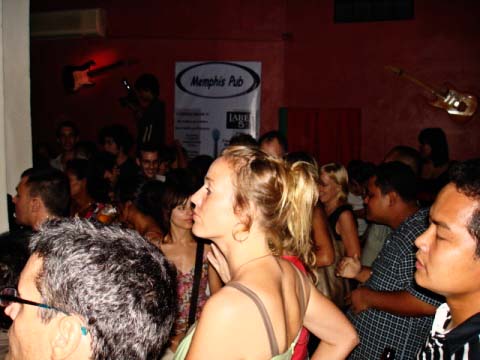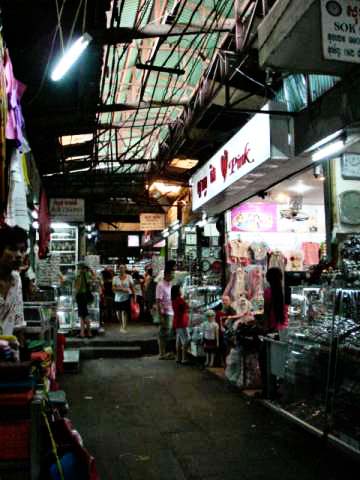These are some of my favorites sights and scenes in Phnom Penh:
* The Royal Palace of Phnom Penh
* The Royal Palace of Phnom Penh

The royal palace seems like a smaller version of the Grand Palace in Bangkok, Thailand.
* Musee Albert Sangut (The National Museum of Cambodia)

The National Museum of Cambodia holds art and architectural treasures worth a closer look.

The Memphis Pub is home to indie bands.

Stop over at the Russian Market for all sorts of merchandise at bargain prices.
By EILEEN PAAT
GMANNews.tv
10th May 2010
If there was a city that has everything you'd ever want for a holiday but still retains a somewhat laid-back and rustic atmosphere, then that city would be Phnom Penh. The capital of Cambodia, Phnom Penh was one of those cities that was at the bottom of my list of places-to-visit-before-you-die, until one fine day in September 2005.
Back then, I was working as a PR consultant in Bangkok and I was looking forward to a holiday - a place to chill out but not too far, as in halfway across the globe, from my place of work.
My friend Cecil, a long-time resident of Phnom Penh, had long been urging me to visit her and check out the local singles and lifestyle scene there. She knew I had been traveling widely in Indochina and the Near East for some time, and she convinced me that it was about time I get to see the sights and write about Phnom Penh, my next-door neighbor city from Bangkok.
And so I flew in and booked a nice hotel in the center of town, overlooking the Tonle Sap River which runs beside the city of Phnom Penh. And I was hooked -- literally enchanted with the city!
But why, you say, when what often comes to mind when someone mentions Phnom Penh are dusty streets, a phalanx of soldiers guarding the roads, and thousands of motorbikes?
These impressions were quickly dispelled after I landed at the Phnom Penh International Airport. My friend Cecil and her friend Vuthdey picked me up, and we had a surprisingly pleasant 15-minute drive into town. We passed through dirt and concrete roads, sharing space with the ubiquitous motorbike and an ox-drawn cart or two.
Immediately, I got attracted to the quaintness of the place, and I'm not talking about white picket fences and little white-washed houses on nice concrete streets here. I'm talking about quaintness with a big Q. Phnom Penh had everything I've ever wanted in a holiday destination: laid-back and provincial charm, Khmer-influenced architecture (especially monuments and old Khmer-style buildings), the wide variety and relatively cheap food, the excitement of finding a really great bargain in flea markets, and vibrant restaurants and watering holes. It was utter bliss!
These days, the scene has changed in many ways. Some of the latest car models are plying the streets. Five-storey buildings have sprouted all over the city. A number of small hotels are all over the place, and the clean roads are made of asphalt or concrete. It's totally different from the Phnom Penh that I first visited five years ago.
The Hidden Charm of Phnom Penh
Over the years, I keep coming back to Phnom Penh because of its numerous charms. One of them would undoubtedly be the Cambodian people who are highly influenced by their glorious past, as indicated by the many notable ruins left behind by their Khmer ancestors. But there are also the less palatable parts of Cambodian history, particularly the Pol Pot years.
In the past decade or so, life has become as normal as it can get. Even though the economy was affected by the economic recession, the Cambodian people still go about their daily life as it was in the ancient past -- with the belief that anything can happen any day as part of their karma.
The resilience of the Cambodian people can be seen when they start telling their sad and disturbing stories, in a very matter-of-fact way. My Cambodian friend Vuthdey occasionally recalls how her family and relatives hid during Pol Pot's reign of terror as his soldiers rounded up all the citizens of the city for extermination, particularly the well-to-do families and the intellectuals. This is the story of the infamous Cambodian "Killing Fields" where most of these families were executed.
That was 35 years ago. Today, remnants of its brutal and gruesome past can be seen at the Tuol Sleng prison, a former school that was turned into a torture chamber for thousands of Cambodians who were deemed “enemies of the state." But the spirit of the citizens of Phnom Penh have prevailed and they are understandably proud of their culture and history.
These are some of my favorites sights and scenes in Phnom Penh:
* The Royal Palace of Phnom Penh
The royal palace seems like a smaller version of the Grand Palace in Bangkok, Thailand.
Built in 1866 with French support and officially opened in 1870 by then King Norodom of the Royal Family of Cambodia, the Royal Palace is not to be missed. From its entrance facing the Mekong River, visitors walk through a rectangular compound where the Royal Palace stands in the middle, with a little temple at the back and a little house with French-inspired architecture.
Originally constructed of wood and later reconstructed in concrete, stucco and brick, the Royal Palace with its gilded curved roofs is reminiscent of Buddhist wats (temples) in Bangkok with their pointy roof gables and a little brass bell hanging at the end that every so often tinkles with the wind.
Manicured lawns add an air of stateliness. Indeed, the Royal Palace of Phnom Penh seems to me like a smaller version of the Grand Palace in Bangkok.
* Musee Albert Sangut (The National Museum of Cambodia)
The National Museum of Cambodia holds art and architectural treasures worth a closer look.
Any history buff will surely love the National Museum of Cambodia. Built in 1920 by architect George Groslier using a fusion of traditional Angkorian Khmer style with later-day Cambodian wat architecture, the National Museum of Cambodia reminds me of a Khmer temple built in the middle of a grassy field.
The entrance of the Museum has massive wooden doors and window shutter paintings, reportedly constructed by the students of the Ecole des Artes Cambodgiens. A musty air hangs over the place, broken only by the rectangular courtyard with a lily pond in the center. Open corridors filled with ancient Khmer and Angkorian statues, waiting to be marked and catalogued for public viewing, surround the courtyard.
Once, I sat beside the lily pond in the middle, amid the fading twilight, imagining myself back during the days of Angkorian kings and queens. As a repository of the country's art and architectural treasures, the National Museum of Cambodia is certainly worth exploring when you’re in Phnom Penh.
* Foreign Correspondents Club (FCC)
The three-storey, whitewashed Colonial-era building overlooking the placid waters of the Tonle Sap river on Sisowath Quay - the famed tourist district of Phnom Penh – is practically a national institution despite the fact that it is fairly new. The FCC opened in 1993, when political upheavals started transforming Cambodia into what it is today.
Climbing the stairs to the second floor, the FCC boasts of a massive centerpiece bar where you can order cocktails and bring them to the comfy wooden sofas, tables and chairs overlooking the river below. Top the fantastic view with an Angkor beer and one of their famed oven-fired pizzas or enchiladas, and you can leave your cares behind while ferryboats ply up and down the river from morning till night.
Behind the FCC is another imposing and historic structure which is unfortunately in a very dilapidated state. This French Colonial building used to house the taxation department and has been around for some time. The stucco building with French-style eaves and doorways conveys opulence despite its rather faded glory. The FCC has bought the building and is reportedly planning to renovate the place for a restaurant, art gallery and library in the near future.
A lazy day down by the river
On a recent holiday in Phnom Penh, I stayed in a small hotel overlooking the river, in the area known as Sisowath Quay. More than a kilometer long, Sisowath Quay hosts a number of bars, pubs, local and foreign food restaurants, spa and foot massage parlors, clothes and accessories boutiques, banks, the Royal Palace and the National Museum of Cambodia.
What amazes me every time I walk down Sisowath Quay is that I always find quite a number of new establishments sprouting up beside the river. Some of my favorites:
The Mansion. It's one of those awesome French-style mansions and buildings that have been renovated and can be found throughout Phnom Penh. Blooming frangipani trees frame the short driveway in front of the mansion where the offices of Mindshare, an international media-buy company, and 141Interactive, an activation company, are housed. To top it all off, there is a swimming pool at the back as well!
Friends Restaurant. A huge colorful oil painting of Angkor Wat greets you at the doorway of this restaurant, the brainchild of the Friends Foundation. It’s a project that provides training and employment for street kids and teenagers. The colorful furnishings and mouth-watering menu are enough to attract the travelers, who often come back for more treats. A little store next door with second-hand books - some of them interesting and hard-to-find ones – and clothes generates additional income for the Foundation.
The Memphis Pub is home to indie bands.
Indie bands at The Memphis Pub. Both expats and locals habitually congregate at The Memphis Pub on a Friday or Saturday evening to listen to the indie bands performing there. One band that stands out is "The Bribes", a conglomerate of different nationalities whose lead singer is Maia Diokno, the youngest daughter of the late senator and nationalist Atty. Jose Diokno. Human rights lawyer by day and jazz singer at night, Maia has had a strong fan base in Phnom Penh for years now. She had her last gig at The Memphis sometime in April, but Phnom Penh’s loss will be Manila’s gain as she scouts for singing gigs in her home town.
Shop till you drop!
Any trip to Phnom Penh is not complete without savoring its shopping places. Although rather “Third Worldly" (there aren't any high-rise shopping centers in Phnom Penh yet; just flea markets and boutiques), there’s a haven for shoppers and bargain hunters in Phsar Toul Tom Poung or what locals call "The Russian Market".
Stop over at the Russian Market for all sorts of merchandise at bargain prices.
Open everyday except Cambodian holidays, the Russian Market houses a number of stalls selling export over-runs, native handicraft, jewelry, DVDs, bags, home furnishings, and other odds and ends. The merchandise is very cheap – tank tops and blouses range from $1.50 to $3 a piece, pants and skirts from $3 to $7. There’s also silver jewelry inlaid with semi-precious stones that can be bought from $3 to 15 per piece, all made in Cambodia.
What more can you ask from a holiday? - YA, GMANews.TV
If there was a city that has everything you'd ever want for a holiday but still retains a somewhat laid-back and rustic atmosphere, then that city would be Phnom Penh. The capital of Cambodia, Phnom Penh was one of those cities that was at the bottom of my list of places-to-visit-before-you-die, until one fine day in September 2005.
Back then, I was working as a PR consultant in Bangkok and I was looking forward to a holiday - a place to chill out but not too far, as in halfway across the globe, from my place of work.
My friend Cecil, a long-time resident of Phnom Penh, had long been urging me to visit her and check out the local singles and lifestyle scene there. She knew I had been traveling widely in Indochina and the Near East for some time, and she convinced me that it was about time I get to see the sights and write about Phnom Penh, my next-door neighbor city from Bangkok.
And so I flew in and booked a nice hotel in the center of town, overlooking the Tonle Sap River which runs beside the city of Phnom Penh. And I was hooked -- literally enchanted with the city!
But why, you say, when what often comes to mind when someone mentions Phnom Penh are dusty streets, a phalanx of soldiers guarding the roads, and thousands of motorbikes?
These impressions were quickly dispelled after I landed at the Phnom Penh International Airport. My friend Cecil and her friend Vuthdey picked me up, and we had a surprisingly pleasant 15-minute drive into town. We passed through dirt and concrete roads, sharing space with the ubiquitous motorbike and an ox-drawn cart or two.
Immediately, I got attracted to the quaintness of the place, and I'm not talking about white picket fences and little white-washed houses on nice concrete streets here. I'm talking about quaintness with a big Q. Phnom Penh had everything I've ever wanted in a holiday destination: laid-back and provincial charm, Khmer-influenced architecture (especially monuments and old Khmer-style buildings), the wide variety and relatively cheap food, the excitement of finding a really great bargain in flea markets, and vibrant restaurants and watering holes. It was utter bliss!
These days, the scene has changed in many ways. Some of the latest car models are plying the streets. Five-storey buildings have sprouted all over the city. A number of small hotels are all over the place, and the clean roads are made of asphalt or concrete. It's totally different from the Phnom Penh that I first visited five years ago.
The Hidden Charm of Phnom Penh
Over the years, I keep coming back to Phnom Penh because of its numerous charms. One of them would undoubtedly be the Cambodian people who are highly influenced by their glorious past, as indicated by the many notable ruins left behind by their Khmer ancestors. But there are also the less palatable parts of Cambodian history, particularly the Pol Pot years.
In the past decade or so, life has become as normal as it can get. Even though the economy was affected by the economic recession, the Cambodian people still go about their daily life as it was in the ancient past -- with the belief that anything can happen any day as part of their karma.
The resilience of the Cambodian people can be seen when they start telling their sad and disturbing stories, in a very matter-of-fact way. My Cambodian friend Vuthdey occasionally recalls how her family and relatives hid during Pol Pot's reign of terror as his soldiers rounded up all the citizens of the city for extermination, particularly the well-to-do families and the intellectuals. This is the story of the infamous Cambodian "Killing Fields" where most of these families were executed.
That was 35 years ago. Today, remnants of its brutal and gruesome past can be seen at the Tuol Sleng prison, a former school that was turned into a torture chamber for thousands of Cambodians who were deemed “enemies of the state." But the spirit of the citizens of Phnom Penh have prevailed and they are understandably proud of their culture and history.
These are some of my favorites sights and scenes in Phnom Penh:
* The Royal Palace of Phnom Penh
The royal palace seems like a smaller version of the Grand Palace in Bangkok, Thailand.
Built in 1866 with French support and officially opened in 1870 by then King Norodom of the Royal Family of Cambodia, the Royal Palace is not to be missed. From its entrance facing the Mekong River, visitors walk through a rectangular compound where the Royal Palace stands in the middle, with a little temple at the back and a little house with French-inspired architecture.
Originally constructed of wood and later reconstructed in concrete, stucco and brick, the Royal Palace with its gilded curved roofs is reminiscent of Buddhist wats (temples) in Bangkok with their pointy roof gables and a little brass bell hanging at the end that every so often tinkles with the wind.
Manicured lawns add an air of stateliness. Indeed, the Royal Palace of Phnom Penh seems to me like a smaller version of the Grand Palace in Bangkok.
* Musee Albert Sangut (The National Museum of Cambodia)
The National Museum of Cambodia holds art and architectural treasures worth a closer look.
Any history buff will surely love the National Museum of Cambodia. Built in 1920 by architect George Groslier using a fusion of traditional Angkorian Khmer style with later-day Cambodian wat architecture, the National Museum of Cambodia reminds me of a Khmer temple built in the middle of a grassy field.
The entrance of the Museum has massive wooden doors and window shutter paintings, reportedly constructed by the students of the Ecole des Artes Cambodgiens. A musty air hangs over the place, broken only by the rectangular courtyard with a lily pond in the center. Open corridors filled with ancient Khmer and Angkorian statues, waiting to be marked and catalogued for public viewing, surround the courtyard.
Once, I sat beside the lily pond in the middle, amid the fading twilight, imagining myself back during the days of Angkorian kings and queens. As a repository of the country's art and architectural treasures, the National Museum of Cambodia is certainly worth exploring when you’re in Phnom Penh.
* Foreign Correspondents Club (FCC)
The three-storey, whitewashed Colonial-era building overlooking the placid waters of the Tonle Sap river on Sisowath Quay - the famed tourist district of Phnom Penh – is practically a national institution despite the fact that it is fairly new. The FCC opened in 1993, when political upheavals started transforming Cambodia into what it is today.
Climbing the stairs to the second floor, the FCC boasts of a massive centerpiece bar where you can order cocktails and bring them to the comfy wooden sofas, tables and chairs overlooking the river below. Top the fantastic view with an Angkor beer and one of their famed oven-fired pizzas or enchiladas, and you can leave your cares behind while ferryboats ply up and down the river from morning till night.
Behind the FCC is another imposing and historic structure which is unfortunately in a very dilapidated state. This French Colonial building used to house the taxation department and has been around for some time. The stucco building with French-style eaves and doorways conveys opulence despite its rather faded glory. The FCC has bought the building and is reportedly planning to renovate the place for a restaurant, art gallery and library in the near future.
A lazy day down by the river
On a recent holiday in Phnom Penh, I stayed in a small hotel overlooking the river, in the area known as Sisowath Quay. More than a kilometer long, Sisowath Quay hosts a number of bars, pubs, local and foreign food restaurants, spa and foot massage parlors, clothes and accessories boutiques, banks, the Royal Palace and the National Museum of Cambodia.
What amazes me every time I walk down Sisowath Quay is that I always find quite a number of new establishments sprouting up beside the river. Some of my favorites:
The Mansion. It's one of those awesome French-style mansions and buildings that have been renovated and can be found throughout Phnom Penh. Blooming frangipani trees frame the short driveway in front of the mansion where the offices of Mindshare, an international media-buy company, and 141Interactive, an activation company, are housed. To top it all off, there is a swimming pool at the back as well!
Friends Restaurant. A huge colorful oil painting of Angkor Wat greets you at the doorway of this restaurant, the brainchild of the Friends Foundation. It’s a project that provides training and employment for street kids and teenagers. The colorful furnishings and mouth-watering menu are enough to attract the travelers, who often come back for more treats. A little store next door with second-hand books - some of them interesting and hard-to-find ones – and clothes generates additional income for the Foundation.
The Memphis Pub is home to indie bands.
Indie bands at The Memphis Pub. Both expats and locals habitually congregate at The Memphis Pub on a Friday or Saturday evening to listen to the indie bands performing there. One band that stands out is "The Bribes", a conglomerate of different nationalities whose lead singer is Maia Diokno, the youngest daughter of the late senator and nationalist Atty. Jose Diokno. Human rights lawyer by day and jazz singer at night, Maia has had a strong fan base in Phnom Penh for years now. She had her last gig at The Memphis sometime in April, but Phnom Penh’s loss will be Manila’s gain as she scouts for singing gigs in her home town.
Shop till you drop!
Any trip to Phnom Penh is not complete without savoring its shopping places. Although rather “Third Worldly" (there aren't any high-rise shopping centers in Phnom Penh yet; just flea markets and boutiques), there’s a haven for shoppers and bargain hunters in Phsar Toul Tom Poung or what locals call "The Russian Market".
Stop over at the Russian Market for all sorts of merchandise at bargain prices.
Open everyday except Cambodian holidays, the Russian Market houses a number of stalls selling export over-runs, native handicraft, jewelry, DVDs, bags, home furnishings, and other odds and ends. The merchandise is very cheap – tank tops and blouses range from $1.50 to $3 a piece, pants and skirts from $3 to $7. There’s also silver jewelry inlaid with semi-precious stones that can be bought from $3 to 15 per piece, all made in Cambodia.
What more can you ask from a holiday? - YA, GMANews.TV

2 comments:
The first photo is not the Royal Palace of Phnom Penh but the famous
pagoda of Unaloum where is not far away from the Royal Palace.
Yes, I notice that too. It is not a Royal Palace, but the famous Unnalom Pagoda where the Buddhist Patriarch resides. It is also where the famous Buddhist Institute is located as well.
Post a Comment